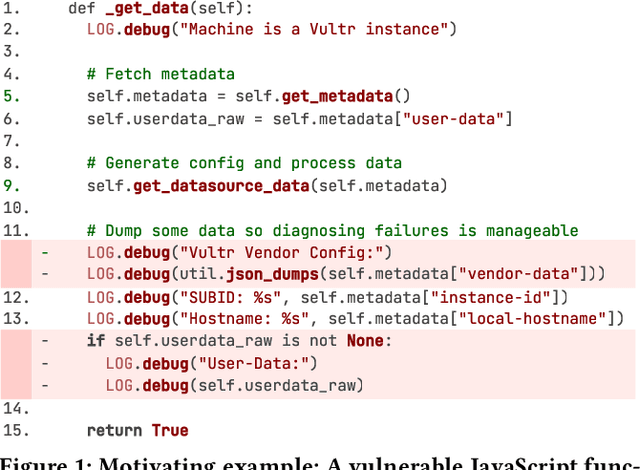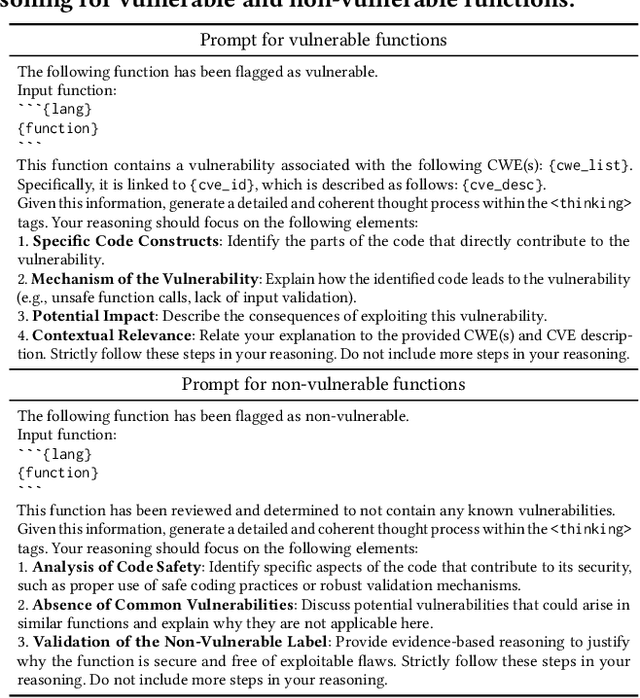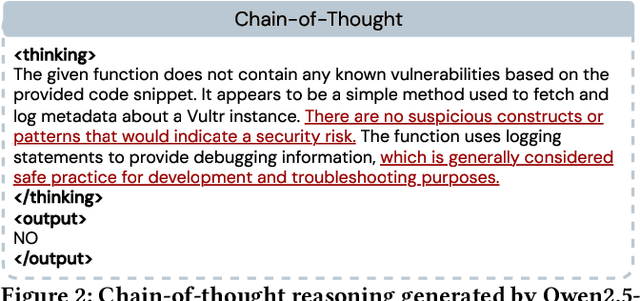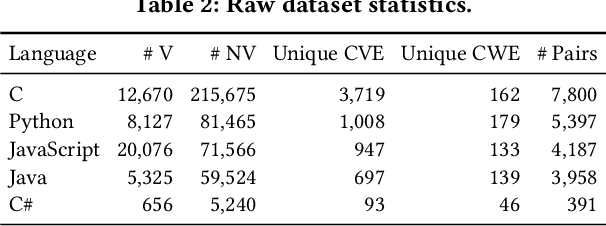David Lo
Singapore Management University
SecureAgentBench: Benchmarking Secure Code Generation under Realistic Vulnerability Scenarios
Sep 26, 2025Abstract:Large language model (LLM) powered code agents are rapidly transforming software engineering by automating tasks such as testing, debugging, and repairing, yet the security risks of their generated code have become a critical concern. Existing benchmarks have offered valuable insights but remain insufficient: they often overlook the genuine context in which vulnerabilities were introduced or adopt narrow evaluation protocols that fail to capture either functional correctness or newly introduced vulnerabilities. We therefore introduce SecureAgentBench, a benchmark of 105 coding tasks designed to rigorously evaluate code agents' capabilities in secure code generation. Each task includes (i) realistic task settings that require multi-file edits in large repositories, (ii) aligned contexts based on real-world open-source vulnerabilities with precisely identified introduction points, and (iii) comprehensive evaluation that combines functionality testing, vulnerability checking through proof-of-concept exploits, and detection of newly introduced vulnerabilities using static analysis. We evaluate three representative agents (SWE-agent, OpenHands, and Aider) with three state-of-the-art LLMs (Claude 3.7 Sonnet, GPT-4.1, and DeepSeek-V3.1). Results show that (i) current agents struggle to produce secure code, as even the best-performing one, SWE-agent supported by DeepSeek-V3.1, achieves merely 15.2% correct-and-secure solutions, (ii) some agents produce functionally correct code but still introduce vulnerabilities, including new ones not previously recorded, and (iii) adding explicit security instructions for agents does not significantly improve secure coding, underscoring the need for further research. These findings establish SecureAgentBench as a rigorous benchmark for secure code generation and a step toward more reliable software development with LLMs.
"My productivity is boosted, but ..." Demystifying Users' Perception on AI Coding Assistants
Aug 17, 2025Abstract:This paper aims to explore fundamental questions in the era when AI coding assistants like GitHub Copilot are widely adopted: what do developers truly value and criticize in AI coding assistants, and what does this reveal about their needs and expectations in real-world software development? Unlike previous studies that conduct observational research in controlled and simulated environments, we analyze extensive, first-hand user reviews of AI coding assistants, which capture developers' authentic perspectives and experiences drawn directly from their actual day-to-day work contexts. We identify 1,085 AI coding assistants from the Visual Studio Code Marketplace. Although they only account for 1.64% of all extensions, we observe a surge in these assistants: over 90% of them are released within the past two years. We then manually analyze the user reviews sampled from 32 AI coding assistants that have sufficient installations and reviews to construct a comprehensive taxonomy of user concerns and feedback about these assistants. We manually annotate each review's attitude when mentioning certain aspects of coding assistants, yielding nuanced insights into user satisfaction and dissatisfaction regarding specific features, concerns, and overall tool performance. Built on top of the findings-including how users demand not just intelligent suggestions but also context-aware, customizable, and resource-efficient interactions-we propose five practical implications and suggestions to guide the enhancement of AI coding assistants that satisfy user needs.
Enhancing Project-Specific Code Completion by Inferring Internal API Information
Jul 28, 2025Abstract:Project-specific code completion is a critical task that leverages context from a project to generate accurate code. State-of-the-art methods use retrieval-augmented generation (RAG) with large language models (LLMs) and project information for code completion. However, they often struggle to incorporate internal API information, which is crucial for accuracy, especially when APIs are not explicitly imported in the file. To address this, we propose a method to infer internal API information without relying on imports. Our method extends the representation of APIs by constructing usage examples and semantic descriptions, building a knowledge base for LLMs to generate relevant completions. We also introduce ProjBench, a benchmark that avoids leaked imports and consists of large-scale real-world projects. Experiments on ProjBench and CrossCodeEval show that our approach significantly outperforms existing methods, improving code exact match by 22.72% and identifier exact match by 18.31%. Additionally, integrating our method with existing baselines boosts code match by 47.80% and identifier match by 35.55%.
An LLM-as-Judge Metric for Bridging the Gap with Human Evaluation in SE Tasks
May 27, 2025Abstract:Large Language Models (LLMs) and other automated techniques have been increasingly used to support software developers by generating software artifacts such as code snippets, patches, and comments. However, accurately assessing the correctness of these generated artifacts remains a significant challenge. On one hand, human evaluation provides high accuracy but is labor-intensive and lacks scalability. On the other hand, other existing automatic evaluation metrics are scalable and require minimal human effort, but they often fail to accurately reflect the actual correctness of generated software artifacts. In this paper, we present SWE-Judge, the first evaluation metric for LLM-as-Ensemble-Judge specifically designed to accurately assess the correctness of generated software artifacts. SWE-Judge first defines five distinct evaluation strategies, each implemented as an independent judge. A dynamic team selection mechanism then identifies the most appropriate subset of judges to produce a final correctness score through ensembling. We evaluate SWE-Judge across a diverse set of software engineering (SE) benchmarks, including CoNaLa, Card2Code, HumanEval-X, APPS, APR-Assess, and Summary-Assess. These benchmarks span three SE tasks: code generation, automated program repair, and code summarization. Experimental results demonstrate that SWE-Judge consistently achieves a higher correlation with human judgments, with improvements ranging from 5.9% to 183.8% over existing automatic metrics. Furthermore, SWE-Judge reaches agreement levels with human annotators that are comparable to inter-annotator agreement in code generation and program repair tasks. These findings underscore SWE-Judge's potential as a scalable and reliable alternative to human evaluation.
CODE-DITING: A Reasoning-Based Metric for Functional Alignment in Code Evaluation
May 26, 2025Abstract:Trustworthy evaluation methods for code snippets play a crucial role in neural code generation. Traditional methods, which either rely on reference solutions or require executable test cases, have inherent limitation in flexibility and scalability. The recent LLM-as-Judge methodology offers a promising alternative by directly evaluating functional consistency between the problem description and the generated code. To systematically understand the landscape of these LLM-as-Judge methods, we conduct a comprehensive empirical study across three diverse datasets. Our investigation reveals the pros and cons of two categories of LLM-as-Judge methods: the methods based on general foundation models can achieve good performance but require complex prompts and lack explainability, while the methods based on reasoning foundation models provide better explainability with simpler prompts but demand substantial computational resources due to their large parameter sizes. To address these limitations, we propose CODE-DITING, a novel code evaluation method that balances accuracy, efficiency and explainability. We develop a data distillation framework that effectively transfers reasoning capabilities from DeepSeek-R1671B to our CODE-DITING 1.5B and 7B models, significantly enhancing evaluation explainability and reducing the computational cost. With the majority vote strategy in the inference process, CODE-DITING 1.5B outperforms all models with the same magnitude of parameters and achieves performance which would normally exhibit in a model with 5 times of parameter scale. CODE-DITING 7B surpasses GPT-4o and DeepSeek-V3 671B, even though it only uses 1% of the parameter volume of these large models. Further experiments show that CODEDITING is robust to preference leakage and can serve as a promising alternative for code evaluation.
Let the Trial Begin: A Mock-Court Approach to Vulnerability Detection using LLM-Based Agents
May 16, 2025Abstract:Detecting vulnerabilities in source code remains a critical yet challenging task, especially when benign and vulnerable functions share significant similarities. In this work, we introduce VulTrial, a courtroom-inspired multi-agent framework designed to enhance automated vulnerability detection. It employs four role-specific agents, which are security researcher, code author, moderator, and review board. Through extensive experiments using GPT-3.5 and GPT-4o we demonstrate that Vultrial outperforms single-agent and multi-agent baselines. Using GPT-4o, VulTrial improves the performance by 102.39% and 84.17% over its respective baseline. Additionally, we show that role-specific instruction tuning in multi-agent with small data (50 pair samples) improves the performance of VulTrial further by 139.89% and 118.30%. Furthermore, we analyze the impact of increasing the number of agent interactions on VulTrial's overall performance. While multi-agent setups inherently incur higher costs due to increased token usage, our findings reveal that applying VulTrial to a cost-effective model like GPT-3.5 can improve its performance by 69.89% compared to GPT-4o in a single-agent setting, at a lower overall cost.
Toward Generalizable Evaluation in the LLM Era: A Survey Beyond Benchmarks
Apr 26, 2025Abstract:Large Language Models (LLMs) are advancing at an amazing speed and have become indispensable across academia, industry, and daily applications. To keep pace with the status quo, this survey probes the core challenges that the rise of LLMs poses for evaluation. We identify and analyze two pivotal transitions: (i) from task-specific to capability-based evaluation, which reorganizes benchmarks around core competencies such as knowledge, reasoning, instruction following, multi-modal understanding, and safety; and (ii) from manual to automated evaluation, encompassing dynamic dataset curation and "LLM-as-a-judge" scoring. Yet, even with these transitions, a crucial obstacle persists: the evaluation generalization issue. Bounded test sets cannot scale alongside models whose abilities grow seemingly without limit. We will dissect this issue, along with the core challenges of the above two transitions, from the perspectives of methods, datasets, evaluators, and metrics. Due to the fast evolving of this field, we will maintain a living GitHub repository (links are in each section) to crowd-source updates and corrections, and warmly invite contributors and collaborators.
Zero-Shot Cross-Domain Code Search without Fine-Tuning
Apr 10, 2025



Abstract:Code search aims to retrieve semantically relevant code snippets for natural language queries. While pre-trained language models (PLMs) have shown remarkable performance in this task, they struggle in cross-domain scenarios, often requiring costly fine-tuning or facing performance drops in zero-shot settings. RAPID, which generates synthetic data for model fine-tuning, is currently the only effective method for zero-shot cross-domain code search. Despite its effectiveness, RAPID demands substantial computational resources for fine-tuning and needs to maintain specialized models for each domain, underscoring the need for a zero-shot, fine-tuning-free approach for cross-domain code search. The key to tackling zero-shot cross-domain code search lies in bridging the gaps among domains. In this work, we propose to break the query-code matching process of code search into two simpler tasks: query-comment matching and code-code matching. Our empirical study reveals the strong complementarity among the three matching schemas in zero-shot cross-domain settings, i.e., query-code, query-comment, and code-code matching. Based on the findings, we propose CodeBridge, a zero-shot, fine-tuning-free approach for cross-domain code search. Specifically, CodeBridge uses Large Language Models (LLMs) to generate comments and pseudo-code, then combines query-code, query-comment, and code-code matching via PLM-based similarity scoring and sampling-based fusion. Experimental results show that our approach outperforms the state-of-the-art PLM-based code search approaches, i.e., CoCoSoDa and UniXcoder, by an average of 21.4% and 24.9% in MRR, respectively, across three datasets. Our approach also yields results that are better than or comparable to those of the zero-shot cross-domain code search approach RAPID, which requires costly fine-tuning.
R2Vul: Learning to Reason about Software Vulnerabilities with Reinforcement Learning and Structured Reasoning Distillation
Apr 07, 2025



Abstract:Large language models (LLMs) have shown promising performance in software vulnerability detection (SVD), yet their reasoning capabilities remain unreliable. Existing approaches relying on chain-of-thought (CoT) struggle to provide relevant and actionable security assessments. Additionally, effective SVD requires not only generating coherent reasoning but also differentiating between well-founded and misleading yet plausible security assessments, an aspect overlooked in prior work. To this end, we introduce R2Vul, a novel approach that distills structured reasoning into small LLMs using reinforcement learning from AI feedback (RLAIF). Through RLAIF, R2Vul enables LLMs to produce structured, security-aware reasoning that is actionable and reliable while explicitly learning to distinguish valid assessments from misleading ones. We evaluate R2Vul across five languages against SAST tools, CoT, instruction tuning, and classification-based baselines. Our results show that R2Vul with structured reasoning distillation enables a 1.5B student LLM to rival larger models while improving generalization to out-of-distribution vulnerabilities. Beyond model improvements, we contribute a large-scale, multilingual preference dataset featuring structured reasoning to support future research in SVD.
Less is More: On the Importance of Data Quality for Unit Test Generation
Feb 20, 2025Abstract:Unit testing is crucial for software development and maintenance. Effective unit testing ensures and improves software quality, but writing unit tests is time-consuming and labor-intensive. Recent studies have proposed deep learning (DL) techniques or large language models (LLMs) to automate unit test generation. These models are usually trained or fine-tuned on large-scale datasets. Despite growing awareness of the importance of data quality, there has been limited research on the quality of datasets used for test generation. To bridge this gap, we systematically examine the impact of noise on the performance of learning-based test generation models. We first apply the open card sorting method to analyze the most popular and largest test generation dataset, Methods2Test, to categorize eight distinct types of noise. Further, we conduct detailed interviews with 17 domain experts to validate and assess the importance, reasonableness, and correctness of the noise taxonomy. Then, we propose CleanTest, an automated noise-cleaning framework designed to improve the quality of test generation datasets. CleanTest comprises three filters: a rule-based syntax filter, a rule-based relevance filter, and a model-based coverage filter. To evaluate its effectiveness, we apply CleanTest on two widely-used test generation datasets, i.e., Methods2Test and Atlas. Our findings indicate that 43.52% and 29.65% of datasets contain noise, highlighting its prevalence. Finally, we conduct comparative experiments using four LLMs (i.e., CodeBERT, AthenaTest, StarCoder, and CodeLlama7B) to assess the impact of noise on test generation performance. The results show that filtering noise positively influences the test generation ability of the models.
 Add to Chrome
Add to Chrome Add to Firefox
Add to Firefox Add to Edge
Add to Edge